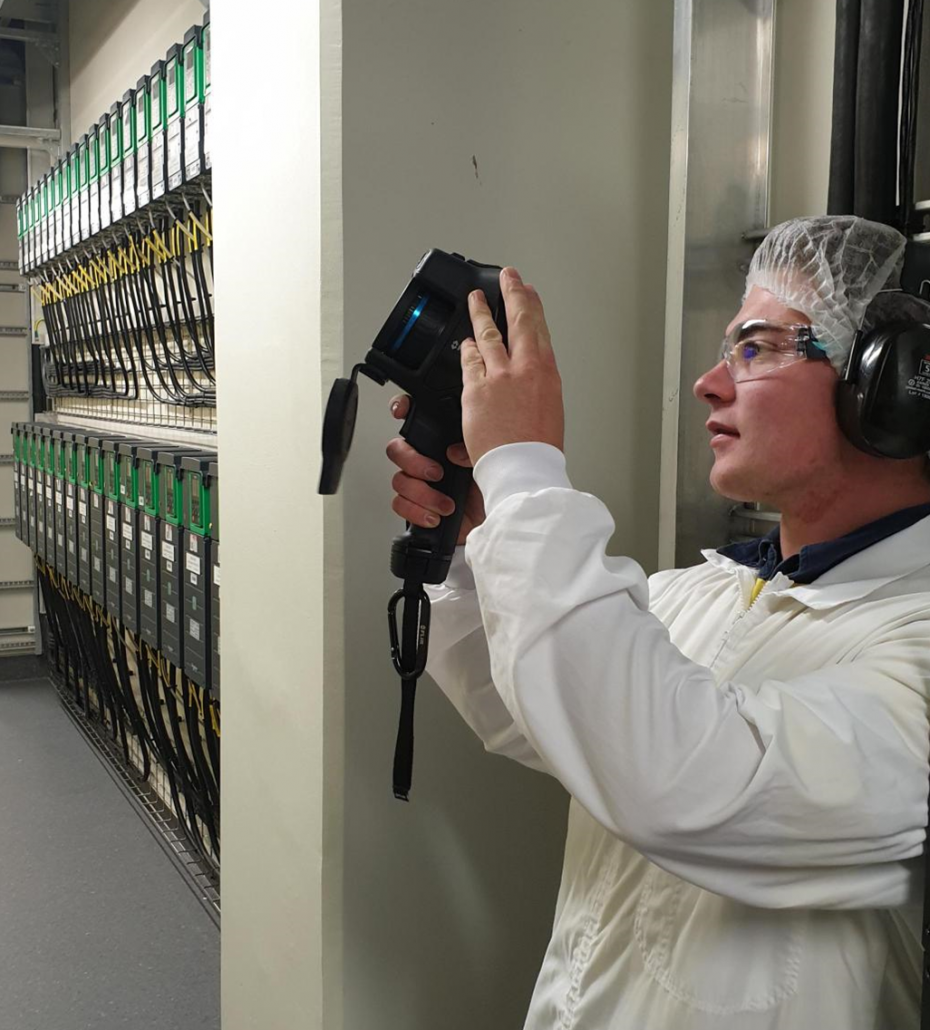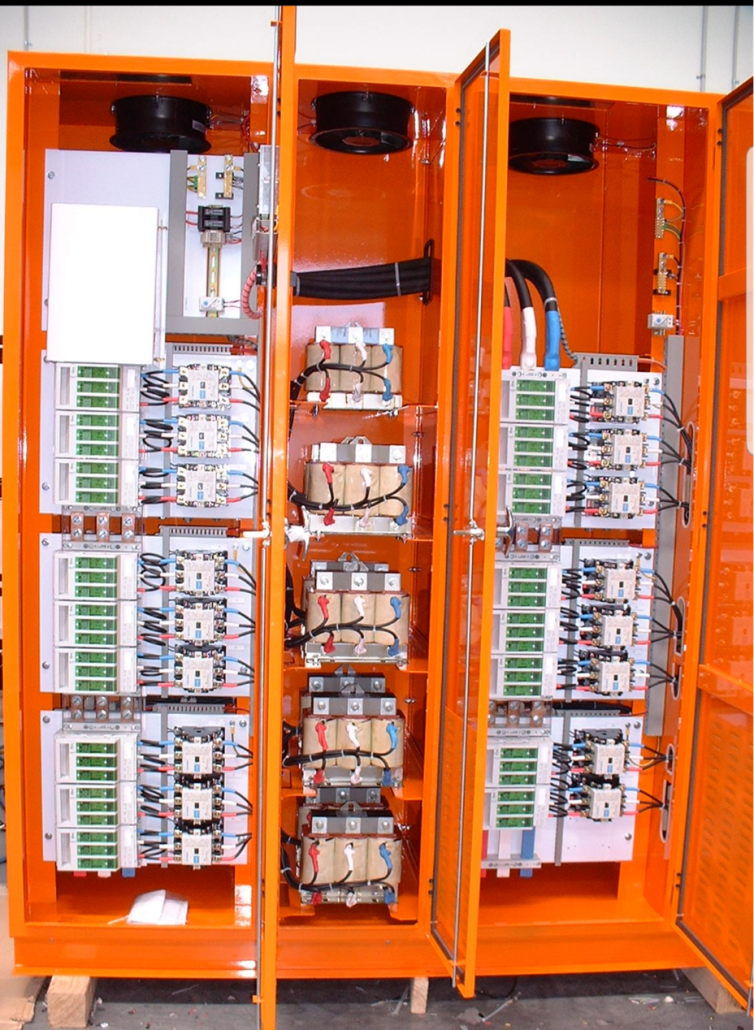Riddle Answers – November 2025 Newsletter

Witch = 10; Jacko lantern = 5; Bat = 1
Jacko lantern + bat + witch = 16
Spotting Electrical Problems Before they Strike
One of the tricky things about electrical systems is that you often can’t see faults until something fails – and by then, the damage (and cost) can be significant.
That’s where thermal imaging (thermography) comes in. It’s a non-intrusive, non-contact method that helps us spot issues you’d never see with the naked eye.
Using a specialised camera, we capture heat patterns in your electrical equipment. Abnormal heat is often the first sign that something’s not right – like loose connections, overloaded circuits, or failing components.
By detecting these problems early, we can fix them before they snowball into costly breakdowns, unplanned downtime, or even fire hazards.
Why Thermal Imaging Matters:
- Catch hidden faults before they cause equipment failure
-
Cut down on expensive reactive repairs
-
Extend the lifespan of your electrical assets
-
Reduce downtime and keep your business running smoothly
When should you get a thermal imaging check?
Routine checks should be part of your preventative maintenance plan, but they’re especially valuable:
-
After major changes or upgrades to your electrical system
-
If you notice burning smells, hot spots, or overheating equipment
-
After electrical failures or unexplained faults
-
Following a power surge or electrical storm
What can we check with thermal imaging?
-
Electrical panels – detect hot spots from loose connections or overloads
-
Circuit breakers – identify faulty operation before failure or fire risk
-
Motors – monitor bearings, windings, and components for wear
-
Switches – spot overload issues early
-
UPS systems – check battery health and wiring
-
Generators – ensure reliability of key components
Why Choose EAS?
The EAS team are trained and experienced in thermal imaging inspections, giving you peace of mind that your electrical systems are safe, efficient, and reliable.
Get in touch to book your thermal imaging check today – Drop us a line or give us a call on 07 834 0505

Are your instruments telling you the truth?
When it comes to running your plant, your measuring devices are the unsung heroes. If they’re even slightly off, product quality, safety and compliance can all take a hit. That’s why regular calibration is so important – and that’s where EAS can make life easier.
Why calibration matters
Your measuring devices don’t stay perfect forever. Even the best ones drift over time. That can mean:
- Wasted product and higher costs
- Safety risks for your team
- Quality issues and unhappy customers
- Trouble meeting regulatory standards
Regular calibration gives you confidence that your readings are spot on, so you can make the right decisions and avoid costly mistakes.
How often should you calibrate?
There’s no one-size-fits-all answer. It depends on things like:
- What the manufacturer recommends
- How critical the device is
- Your past experience with that instrument
- National standards or compliance requirements
We can help you figure out the right schedule for your site, so you stay on top of it without overdoing it.
Device vs Loop Calibration – what’s the difference?
- Device calibration:
- Checks one specific device.
- It’s tested when installed and re-checked at intervals.
- Loop calibration:
- Looks at the entire system – sensors, transmitters, wiring and more – to make sure everything works together accurately.
Not sure which you need? We’ll take care of that too and we handle the paperwork as well!
Every calibration we do comes with an official certificate so your records are always up to date – no chasing, no headaches.
Let EAS make it easy
Our trained, experienced team takes care of the whole process, leaving you with accurate data and fewer worries.
Need a device calibrated or want to set up a simple calibration plan?
Give the EAS team a call today on 07 834 0505 and we’ll get you sorted.

CUT COSTS, NOT CORNERS: HOW TO SLASH ENERGY USE IN YOUR PLANT
Keen to reduce your energy spend and boost the performance of your plant at the same time?
You’re not alone – with power prices constantly on the rise, more and more businesses are looking for ways to run leaner, smarter, and more sustainably. The good news is, with the right projects and a solid plan, you can cut energy use without cutting productivity.
Step One: Set your baseline so you know what you’re working with
Before you can start saving energy, you’ve got to understand how much you’re using – and where it’s going. Think of this as your energy “health check.”
- Pull your power bills
Start with 12 months of electricity bills to get a picture of your seasonal highs and lows. Look at total kWh used, peak demand charges, and time-of-use tariffs. This helps you identify patterns – like spikes during certain times or shifts. - Walk the floor
Do a physical walk-through of your plant to get a feel for what’s running, when, and why. You’ll often find equipment left running unnecessarily, or areas that are over-lit. - Install smart energy meters
This is where the real gold is. We can install sub-meters on different parts of your plant – for example, lighting circuits, air compressors, or specific production lines. This lets you see exactly which areas are guzzling power. - Log it and learn
Once your monitoring is up and running, gather data for a few weeks or months. The longer you track, the clearer the picture. This data forms the benchmark you’ll use to measure improvements against.
Step 2: Set reduction targets
Most sites can realistically aim for 10–20% energy reduction in the first 12–18 months with the right changes in place.
Step 3: Prioritise projects with quick wins & then plan for long-term gains
Start with low-cost, high-impact projects – think lighting, compressed air, or power factor correction.
Bigger upgrades (like automation, motor control, or load management) take longer but can deliver serious savings.
- LED Lighting Upgrades
Lighting can account for up to 30% of your total energy bill. Swapping old halogens or fluorescents for high-efficiency LEDs cuts consumption and improves light quality on-site. - Power Factor Correction (PFC)
Poor power factor means you’re paying for power you’re not even using. A properly sized PFC unit can reduce your demand charges and improve equipment life. - Compressed Air Optimisation
Leaks, poor control, or outdated systems are common culprits for energy waste. Upgrades or simple repairs can have a massive impact. - Automation & Control Systems
Automating equipment to run only when needed can save thousands – particularly on processes that don’t need to run 24/7.
Step 4: Monitor and maintain
Use smart monitoring tools for energy use and load management to track how you’re going with your energy savings.
With a strong focus on energy management you can lower power bills, reduce downtime, improve working conditions with better lighting and smarter systems as well as achieving the environmental wins.
How EAS Can Help
At EAS, we don’t just throw gear at the problem – we take the time to understand your site, your goals, and what success looks like for your team. Whether you want a full plant-wide energy audit or just need help swapping out some lights, we’ve got the know-how and the crew to get it sorted.
Ready to Get Started?
If you’re keen to start trimming your energy bills and future-proofing your plant, get in touch with the EAS team or give us a bell on 07 834 0505 – let’s make your plant work smarter, not harder.

August 2025 Riddle

Source: mindyourlogic.com
The answer is 109.
Need to know how we worked it out?
Tree = 10 (3 trees = 30)
Pot = 7 (38 – 10 (tree) = 28 /4 (pots) = 7
Cup of tea = 6 (3 cups of tea = 18)
One Pot (7) + (tree in a pot (17) x cup of tea(6)) = 109
A simple guide to motors
Motors are used to turn electricity into movement. Whether it’s a fan, pump, conveyor, or something more complex like a milling machine, motors are behind the scenes doing the hard work.
There are lots of different types of motors. They vary based on whether they use AC (alternating current) or DC (direct current) power, and how they generate that movement.
Here’s a quick overview of the common types and where they’re used.
DC Motors – Good for High Torque & Simple Control
Brushed DC Motors
- Easy to use and control
- Used in small appliances, medical dispensers, and packaging machines
- Need regular maintenance because the brushes wear out
Brushless DC Motors (BLDC)
- No brushes = less maintenance
- Good for high precision work
- Found in robot arms, CNC machines, and motor drives
Stepper Motors
- Move in small, accurate steps
- Great for things that need exact position control like printers, imaging equipment, and CNC tools
AC Motors – Powerful & Common in Industrial Setups
Induction Motors
- Most common type (used in 80% of motor-driven systems)
- Used in everything from home fans to big factory equipment
- Come in single-phase (for smaller jobs) and three-phase (for bigger industrial machinery)
Single-Phase Induction Motors are used in:
- Pumps, compressors, small fans, drills
Three-Phase Induction Motors are used in:
- Cranes, lifts, hoists, lathe machines, crushers, mills
- They’re tough, low-maintenance, and ideal for high-load applications
Synchronous Motors
- Run at a steady speed, no matter the load
- Best for applications where exact speed control is needed
- Used in compressors, pumps, and industrial mills
What to Think About When Choosing a Motor
Picking the right motor for your business or operation depends on:
- Application – What’s the motor powering?
- Power supply – AC or DC? What voltage/current do you have?
- Torque & speed – Do you need steady, strong force or high speed?
- Environment – Will it be exposed to dust, water, or heat?
- Control – Do you need variable speed or exact position control?
- Duty cycle – Is it running all day or just in bursts?
These things help determine the right type, size, and setup of motor you’ll need.
Need Help Choosing the Right Motor?
Whether you’re replacing a motor or installing one for a new process, it’s important to get it right. The wrong motor can cause breakdowns, wasted energy, or poor performance.
That’s where EAS can help:
At Electrical & Automation Solutions (EAS), we can help you choose the right motor, install it properly, and keep it running smoothly with regular maintenance and servicing.
Give us a call today on 07 834 0505 for expert advice or a quote—we’re here to help keep your business running at full speed.

Slash your power bills with solar
Thinking about cutting your energy costs and making your business more future-ready? Now’s the time to look into solar.
Solar power is a smart move for farms and businesses across New Zealand. Whether you’re running irrigation, cold storage, or processing operations, you know how unpredictable and expensive power bills can get. Solar gives you back control—helping you reduce your energy costs, rely less on the grid, and even earn from feeding extra power back into the network.
For many high-use operations, the system pays for itself in as little as 5–7 years.
Here’s why solar makes sense for industrial and farming businesses:
Why Go Solar?
- Cut Power Costs
Solar lets you generate your own power on site—reducing your monthly bills and your reliance on the grid, especially when peak rates hit. - Stay Ahead of Rising Prices
Electricity prices are climbing every year. With solar, you lock in savings and reduce your exposure to future price hikes. - Show You’re Serious About Sustainability
Investing in solar sends a clear message—you care about long-term success and doing your part for the environment. It’s a win for your business and your brand. - Long-Lasting & Low Maintenance
With no moving parts, solar panels are built tough for Kiwi conditions and need very little upkeep. Many come with a 25-year warranty—so it’s a long-term solution you can count on. - Keep the Lights On During Outages
Pair your solar setup with battery storage and you’ve got backup power when the grid goes down—ideal for essential systems like fridges, pumps or plant.
Government Support & Bank Finance
Right now, there are great support options that make solar even more affordable:
- Solar on Farms (EECA)
Free advice, technical support and finance options tailored for high-energy farms. - Investment Boost Tax Incentive
The new Investment Boost could allow you to claim an upfront 20% tax deduction on solar systems in year one, and depreciate the rest over time. - Low-Interest Loans
NZ banks are backing green business upgrades. For example: ASB is offering 5 years interest-free on up to $150,000 for solar and battery systems on rural properties. Available for new and existing ASB rural customers until 15 December 2025 (terms apply).Other banks are also offering low-interest green loans—talk to your provider about what’s on offer.
How to Get Started
- Give EAS a call on 07 834 0505 or flick us an email—we’ll sort you a no-obligation quote.
- Get in touch with your bank (like ASB) about low interest finance options.
- Talk to your accountant about claiming the 20% tax break and start saving from day one.
Don’t Wait—Get Ready for Summer Sun
There’s never been a better time to go solar. With strong returns, great finance options and summer around the corner, now’s the time to lock in a system that’ll keep paying off for years to come.
Ready to get started? Contact the EAS team today and let’s talk solar.




